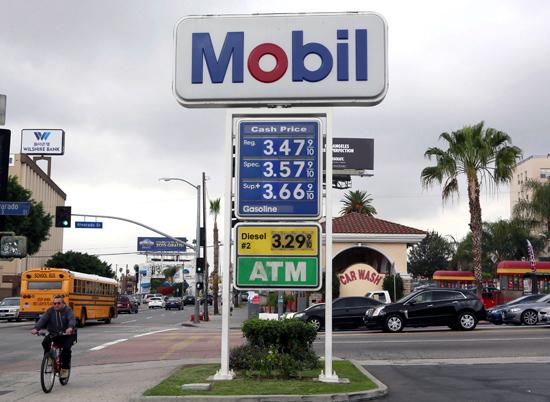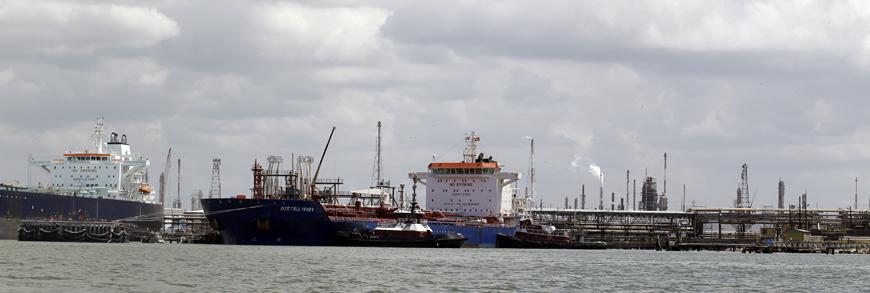You are here
Oil earnings surge but some question skimpy investment
By AFP - Apr 29,2017 - Last updated at Apr 29,2017

Representative Jeff Duncan rolls up his pant leg to reveal a Trump sock at an event where US President Donald Trump signed an executive order to expand drilling for oil at the White House in Washington, US, on Friday (Reuters photo)
NEW YORK — Rising crude prices drove huge profits for US oil industry giants, but key figures in the sector have raised concerns about low investments in exploration and production.
They warn that continued tepid oilfield investment creates the threat of a supply crunch down the road.
As petroleum prices have stabilised over the last year following actions by the Organisation of Petroleum Exporting Countries (OPEC), oil companies have ramped up investment in key US shale regions such as the Permian Basin in Texas.
But activity outside of the US has remained sluggish, evidence of what the International Energy Agency (IEA) called a "two-speed" oil market that it warns could lead to a supply crunch.
The investment restraint "brings an additional cause of concern for global energy security at a time of heightened geopolitical risks in some major producer countries, such as Venezuela", the IEA said this week.
Oil majors ExxonMobil and Chevron on Friday reported strong first quarter earnings as they reaped the benefit of higher crude prices.
Exxon's earnings more than doubled to $4 billion on strong profit growth in its exploration and production business.
Chevron reported $2.7 billion in profits, a far cry from the loss of $725 million in the year-ago period when the industry was mired in a two-year slump. Chief Executive John Watson said the company remains in belt-tightening mode.
The results came as President Donald Trump signed an executive order aimed at opening up more offshore territory to development, including in the arctic. Industry officials praised the action, but said any new leasing would not be available until 2019 at the earliest and that production would likely not hit markets for at least decade.
The improved profits were largely expected as US oil prices were above $50 a barrel for most of the first quarter, after hovering below $40 a barrel for most of the comparable period of 2016.
However, the IEA, which represents governments of oil consuming countries, said oil discoveries declined in 2016 and final investment decisions on major projects have slipped to the lowest level since the 1940s.
"The key question for the future of the oil market is for how long can a surge in US shale supplies make up for the slow pace of growth elsewhere in the oil sector," IEA executive director Fatih Birol said.
Shaky oil prices
Paul Kibsgaard, chief executive of leading oil services firm Schlumberger, warned that "the continuing underinvestment in new supply is increasing the likelihood of a medium-term supply deficit."
The company also saw first-quarter earnings swing back into positive territory.
Schlumberger's non-US activity "reached a bottom in all markets," Kibsgaard said last week. "But for Q2 we only see at this stage flat underlying activity."
Analysts say increased US shale activity was the first to be triggered by higher prices because projects are smaller in scale and require shorter cycle times compared with ventures in remote areas or offshore.
At the same time, the very speed in which shale production can ramp up has acted as a ceiling on oil prices, because of concerns runaway output will flood the market.
ExxonMobil vice president Jeff Woodbury said there were "a lot of variables" behind the company's investment restraint.
While underlying energy demand growth remains solid and OPEC has generally complied with its production limits, Woodbury said, strong growth in North American output and lofty global inventories also factor in to investment decisions.
"The macro environment would still indicate the need to be cautious going forward," he said on a conference call with analysts.
Woodbury cited a series of discoveries offshore of Guyana on the northern coast of South America as evidence the company remains active in exploration.
The company also has taken advantage of low costs from suppliers in 2016 to shoot 60,000 kilometres of seismic data, the first stage in exploration.
Shares of ExxonMobil rose 0.5 per cent to $81.65, while Chevron climbed 1.1 per cent to $106.70.
Related Articles
NEW YORK — US oil giants Chevron and ExxonMobil have signalled further belt-tightening ahead as the industry responds to lower oil prices th
NEW YORK — ExxonMobil and Chevron reported soaring profit on Friday despite lower oil and natural gas volumes as the petroleum giants return
NEW YORK — Plunging oil prices battered oil giants' profits in the first quarter, another blow following credit downgrades, lay-offs and dri














